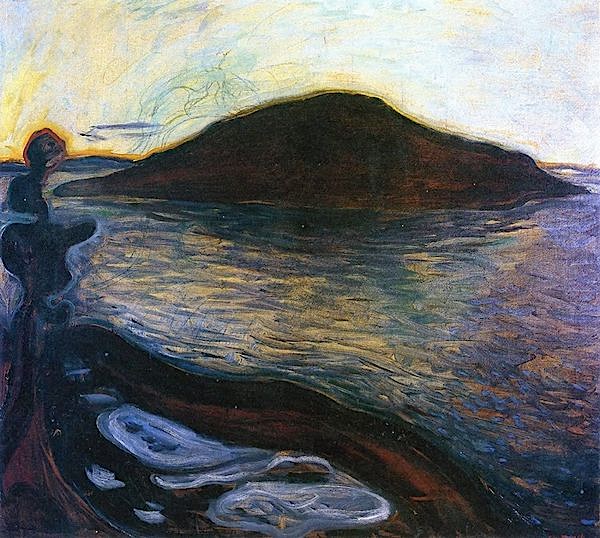Fjord D'oslo / Ile de Jeløya (140m)
Norvège
In " The Island ", huile sur toile, 1900, Collection privée
A propos de ce tableau
L'ile de Jeløya a l'extrémité du Fjord d'Oslo est connue pour avoir été une des sources d'inspiration principales des paysages peints par Edvard Munch.
Le relief
Le fjord d'Oslo est un fjord du Sud de la Norvège, débouchant au large sur le détroit de Skagerrak, et au fond duquel se trouve la capitale du pays : Oslo. Il mesure 17 kilomètres de long pour un kilomètre de large au passage le plus étroit au niveau de la ville de Drøbak. Géologiquement, il correspond au rift d'Oslo. L'ile de Jeløya était en fait une péninsule du fjord d'Oslo, mais elle a
été séparée du continent en 1855 par le canal de Moss-, un canal de 20
mètres de large construit à travers l' isthme bas. Le pont-canal
-constitue le lien entre Jeløya et le continent à Moss. Avec 19 km2 , Jeløya (140m) est la plus grande île du fjord d'Oslo. Géologiquement, Jeløya est en grande partie constituée d'un jeune type de roche de lave de la période Permienne D'autres îles du fjord d'Oslo formées au cours de la même période comprennent Revlingen, Eldøya Missingene et Søsterøyene. Du grès Ringerike se trouve dans certaines parties de Jeløya et des céphalaspides fossiles ont été trouvés. La plus grande moraine norvégienne de la période glaciaire traverse Jeløya, va à l'est de Moss et Rygge et continue à travers la Suède jusqu'en Finlande. Jeløya est un site sur lequel beaucoup de manisons de campagne et de fermes sont intallées, notamment Grønli gård et Kubberød gård. Grimsrød gård a hébergé Edvard Munch pendant plusieurs années. Roed gård a été créé en tant que centre artistique et culturel combiné. Alby gård abrite l'une des galeries d'art les plus connues de Norvège, la Galleri F 15.
Le peintre
Edvard Munch, prononcé est un peintre et graveur expressionniste norvégien. Edvard Munch peut, a posteriori, être considéré après l'exposition berlinoise de 1892, comme le pionnier de l'expressionnisme dans la peinture moderne. Il est très tôt réputé pour son appartenance à une nouvelle époque artistique en Allemagne et en Europe centrale. L'importance de son œuvre est aujourd'hui reconnue en Europe et dans le monde. Les œuvres de Munch les plus connues sont celles conçues au début des années 1890, notamment Le Cri. Son œuvre ne connaît véritablement le succès dans les pays nordiques qu'à partir de 1909, grâce à la grande exposition rétrospective organisée par son ami Jappe Nilssen et par Jens Thiis, directeur de la galerie nationale d'Oslo. Le peintre absent est momentanément convalescent dans une clinique privée de Copenhague, après y être entré en état de dépression nerveuse, victime de troubles graves du comportement, physiques et nerveux, en 1908. Ses techniques de prédilection sont essentiellement la peinture et la tempera sur carton. Il est aussi un pionnier de l'art accessible à tous, un art dévoilé, montré et non caché, dans les rues et les espaces publics, dans les divers lieux de nature.Edvard Munch a toujours été captivé par les paysages de rivage du fjord d'Oslo (ci-dessus), qu'il a découverts dans sa jeunesse par des chemins de terre, puis jeune artiste depuis la mer grâce à Hans Jaeger, capitaine affréteur de petits navires d'excursion et de cabotage de loisir. Quelques-unes de ses contrées sont devenues des lieux emblématiques de sa vie.
________________________________________
2011-2024 - Gravir les montagnes en peinture
Un blog de Francis Rousseau

%20%20Winter%20at%20the%20Sognefjord%20(February%201827)%20Oil%20on%20canvas,%2075.5%20x%2061.5%20cm.%20Nasjonalgalleriet,%20Oslo.jpg)












